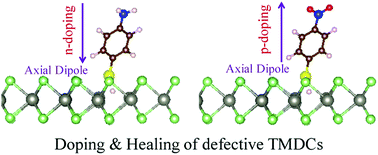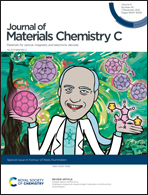Combined healing and doping of transition metal dichalcogenides through molecular functionalization†
Abstract
Transition metal dichalcogenides (TMDCs) are emerging as promising two-dimensional (2D) materials. Yet, TMDCs are prone to inherent defects such as chalcogen vacancies, which are detrimental to charge transport. Passivation of these vacancies via molecular functionalization is an efficient strategy, not only to heal the active defects and improve the charge transport characteristics of TMDCs, but also to engineer their properties by appropriate selection of the passivating molecules. Herein, Density-Functional Theory (DFT) calculations are combined with ab initio Molecular Dynamics (abMD) simulations to elucidate the mechanism of molecular passivation in defective WS2 and WSe2 monolayers containing chalcogen vacancies that are functionalized with thiophenol molecules. We demonstrate that functionalized thiophenol molecules act as molecular dopants inducing n-/p- type doping in defective WS2 and WSe2 monolayers, in addition to healing the electronic mid-gap defect states caused by the chalcogen vacancies in a dynamic way. The electron donating and/or withdrawing nature of passivating thiophenol molecules is found to modulate both the amount of dipole induced doping in defective TMDCs and the magnitude of their interaction strength, which in-turn govern the extent of dynamic defect healing and subsequent recovery of the electronic band structure in defect passivated TMDCs.

- This article is part of the themed collections: Special issue in honour of Kees Hummelen and 2021 Journal of Materials Chemistry C most popular articles


 Please wait while we load your content...
Please wait while we load your content...